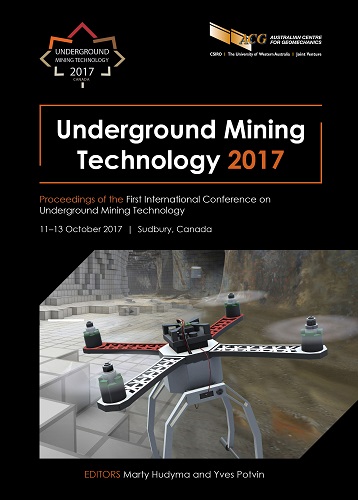Reliable in situ rock stress measurement from the excavation surface

|
Authors: Siren, T; Hakala, M; Perras, MA |
DOI https://doi.org/10.36487/ACG_rep/1710_38_Perras
Cite As:
Siren, T, Hakala, M & Perras, MA 2017, 'Reliable in situ rock stress measurement from the excavation surface', in M Hudyma & Y Potvin (eds), UMT 2017: Proceedings of the First International Conference on Underground Mining Technology, Australian Centre for Geomechanics, Perth, pp. 477-486, https://doi.org/10.36487/ACG_rep/1710_38_Perras
Abstract:
Measuring rock stress has always been a challenging task. Although borehole overcoring stress methods produce a 3D stress state if multiple measurements at different orientations are conducted, the variation in the result is commonly high and only representative of a small area that can be affected by local geology. Furthermore, these methods suffer from low success rates because of glue-related problems or core disking in highly stressed rocks. To overcome these problems, a new method was developed to measure the induced stresses in the vicinity of an excavated surface and further to use these results to interpret the in situ state of stress at the excavation-scale. The new linear variable differential transformer (LVDT) cell method described in this paper produces a 3D stress state while being less expensive than traditional methods, fast, and produces more repeatable and reliable results. Key advances are glueless mounting, utilisation of a compact drill rig, and side coring technique for high-stress conditions to overcome core disking. The reliability of the solution has been proven by comparing against known rock stress conditions at the Äspö Hard Rock Laboratory in Sweden. Since 2009, in situ stress measurements have been carried out at over 10 sites in Scandinavia in underground laboratories, hydropower excavations and mines from 15 m up to 1.4 km below surface. Also, the method is in production use in several mines, proving it to be a reliable source of data for the changing stress field around the mine during production.
Keywords: in situ, stress, measurement, rock, overcoring, sidecoring, LVDT cell
References:
Berg, S & Sjöberg, J 2009, Overcoring Rock Stress Measurements in Drillholes ONK-PP169 and ONK-PP170 Olkiluoto, Posiva Working Report 2009-20, Posiva Oy, Eurajoki.
Christiansson, R & Jansson, T 2003, ‘A test of different stress measurement methods in two orthogonal bore holes in the Äspö Hard Rock Laboratory (HRL), Sweden’, International Journal of Rock Mechanics and Mining Sciences, vol. 40, no. 7–8,
pp. 1161–1172.
Doe, TW, Zieger, M, Enachescu, C & Böhner, J 2006, ‘In situ stress measurements in exploratory boreholes’, Felsbau, vol. 24, no. 4, pp. 39–47.
Evans, K & Engelder, T 1989, ‘Some problems in estimating horizontal stress magnitude in thrust regimes’, International Journal Rock Mechanics Mining Science & Geomechanics Abstracts, vol. 26, no. 6, pp. 647–660.
Hakala, M 2016, LVDT Cell Method - and Development of In situ Stress Measurement Techniques in Finland, session keynote at the 7th International Symposium on In Situ Rock Stress held from May 10–12 2016, Tampere.
Hakala, M, Hakala, V, Heine, J, Kemppainen, K, Savunen, J, Sireni, S, Siren, T, Ström, J & Valli, J 2017, In Situ Stress Measurements in ONKALO with LVDT – Cell, Posiva Report 20-2016, Posiva Oy, Eurajoki.
Hakala, M, Kemppainen, K, Siren, T, Heine, J, Christiansson, R, Martin, CD & Koskinen, T 2012, ‘Experience with a new LVDT cell to measure in situ stress from an existing excavation’, Proceedings of the 2012 ISRM International Symposium: EUROCK 2012, International Society for Rock Mechanics, Lisbon.
Hakala, M, Siren, T, Kemppainen, K, Christiansson, R & Martin, CD 2014, In situ Stress Measurement with LVDT Cell – Method Description and Verification, Posiva Report 2012-43, Posiva Oy, Eurajoki.
Lahaie, F, Gunzburger, Y, Ben Ouanas, A, Barnichon, JD & Piguet, JP 2010, ‘Impact of epoxy glue curing time on the quality of overcoring stress measurements in low-temperature environments’, Proceedings of the 5th International Symposium on In situ Rock Stress, International Society for Rock Mechanics, Lisbon.
Martin, CD, Read, RS, & Chandler, NA 1990, ‘Does scale influence in situ stress measurements? — Some findings at the Underground Research Laboratory’, Proceedings of the First International Workshop on Scale Effects in Rock Masses,
A.A. Balkema, Rotterdam, pp. 307—316.
Perras, M & Diederichs, M 2016, ‘Predicting excavation damage zone depths in brittle rock’, Journal of Rock Mechanics and Geotechnical Engineering, vol. 8, no. 1, pp. 60–74.
Posiva 2012, Olkiluoto Site Description 2011, Posiva Report 2011-02, Posiva Oy, Eurajoki.
Siren, T, Rinne, M & Kantia, P 2015, ‘Considerations and observations of stress-induced and construction-induced excavation damage zone in crystalline rock’, International Journal of Rock Mechanics and Mining Sciences, vol. 73, pp. 165–174.
Wettainen, T & Jonsson, K 2017, ‘Stress measurements in LKAB Malmberget mine’, Proceedings of Bergmekanikdagen 2017, Swedish Rock Mechanics Group, in Swedish.
© Copyright 2025, Australian Centre for Geomechanics (ACG), The University of Western Australia. All rights reserved.
View copyright/legal information
Please direct any queries or error reports to repository-acg@uwa.edu.au
View copyright/legal information
Please direct any queries or error reports to repository-acg@uwa.edu.au